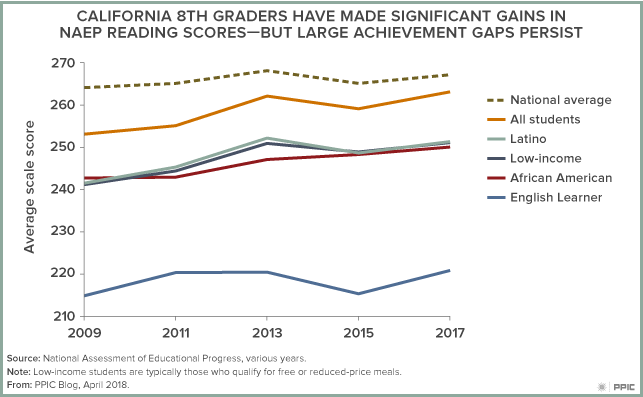New data on the educational progress of California’s K–12 students offers a mixed picture: there have been sizable gains in grade 8 reading scores, but more work is needed to close achievement gaps for English Learner, low-income, and African American and Latino students.
The data comes from the 2017 National Assessment of Educational Progress (NAEP), commonly referred to as the nation’s report card. Administered periodically in grades 4, 8, and 12, NAEP serves as a common yardstick for states and informs many national policy decisions.
The NAEP results show that the average reading score for California 8th graders has risen from 259 to 263. While the latest score is still below the national average (267), it marks a significant improvement, and the state’s 4 point gain is larger than the 1 point increase at the national level. The increase is driven by improvement at both ends performance scale: fewer students performed at the lowest level and more students performed at the advanced level.
However, there were no significant improvements in grade 8 math and no gains in either subject in grade 4. Also, California did not see any significant narrowing of its student achievement gaps. For instance, the average reading score for Latino students in grade 8 was 27 points lower than that of white students; this gap is not significantly different from the 30 point gap in 1998. Similarly, the average score for low-income students was 28 points lower than that of other students, and that gap is not different than it was as in 1998 (32 points).

The NAEP results provide a useful benchmark of student performance; this is especially important in light of the sea changes under way in California’s public K–12 system. The state revamped its school finance and accountability systems with a focus on improving outcomes among English Learners and other “high-need” students. It also adopted new educational standards in math, English language arts, science, and English language development, and implemented a new assessment system.
A recent PPIC survey finds that a solid majority of adults believe that the financial reforms, in particular, will improve the achievement of English Learners and low-income students. As the reforms take hold, PPIC will continue to monitor their impact.




